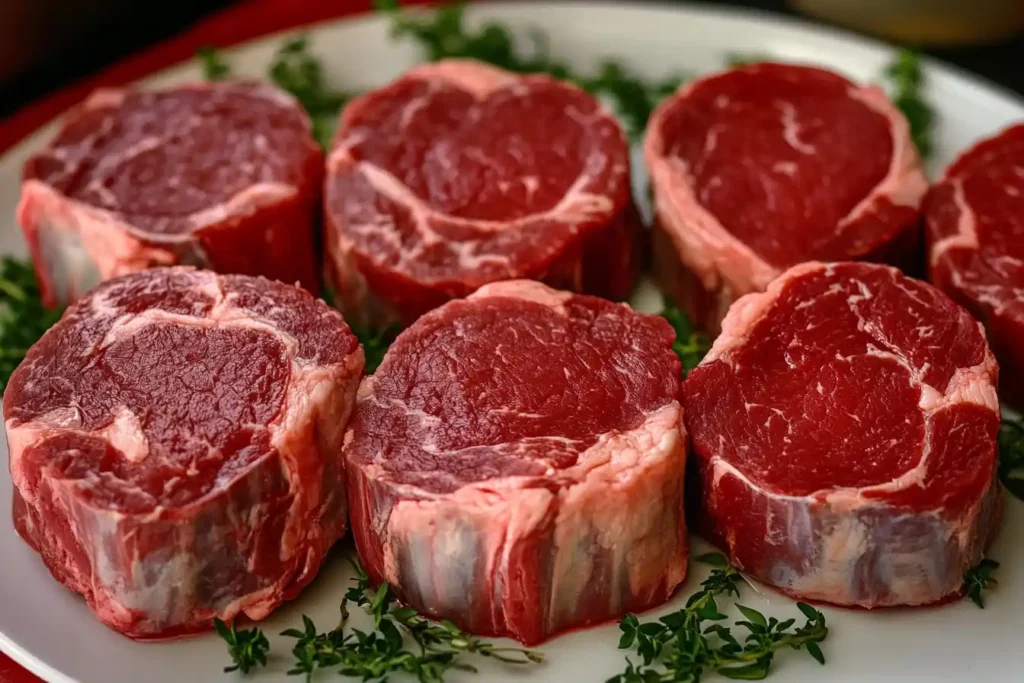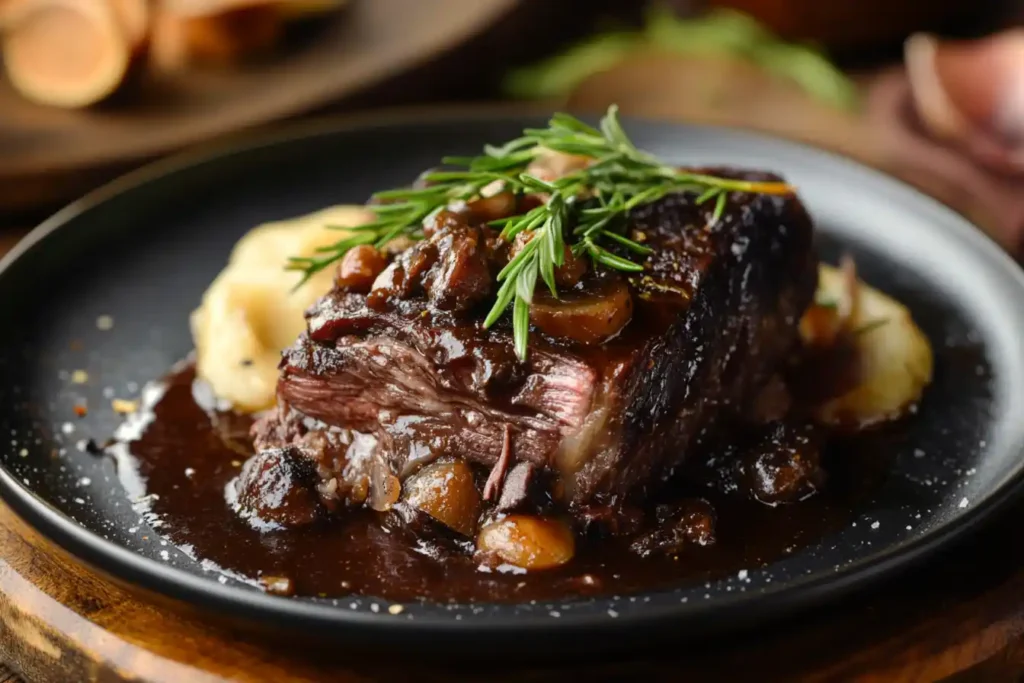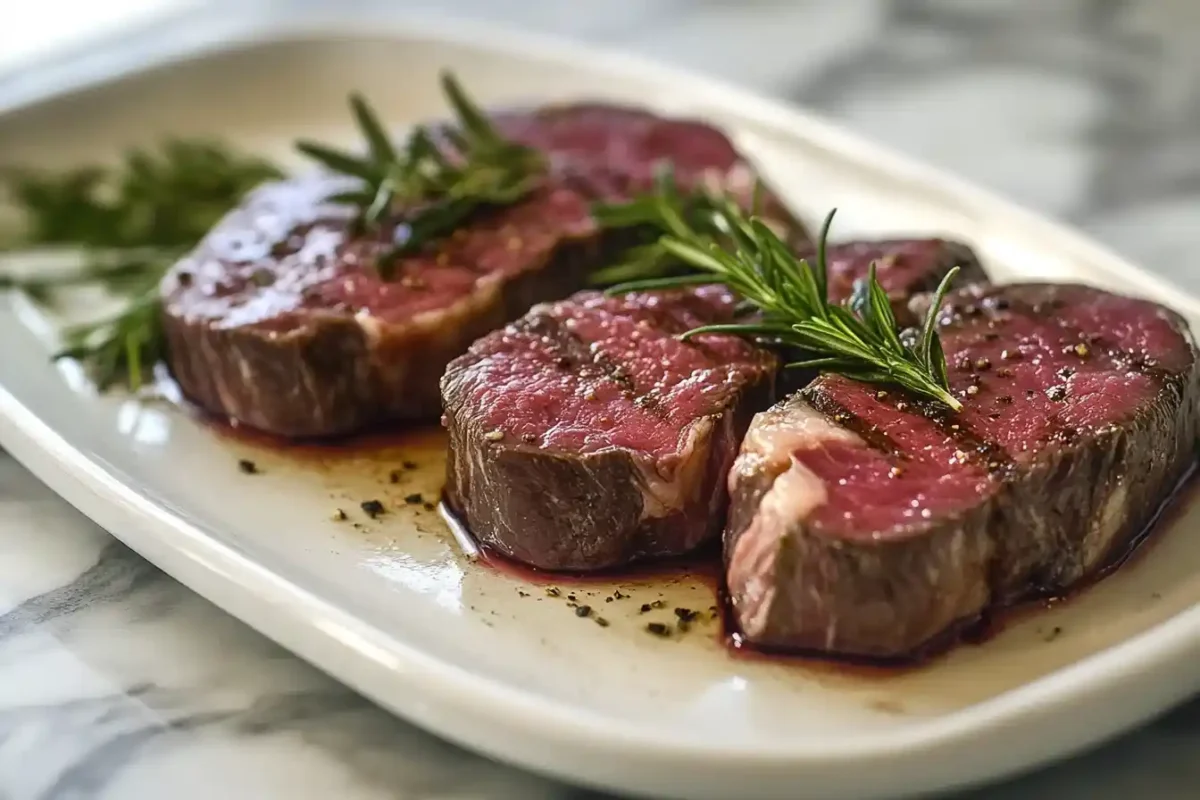Introduction to Beef Cheek Meat
What is Beef Cheek Meat?
distinct and flavorful cut derived from the cheek muscles of a cow. Known for its rich taste and unparalleled tenderness when cooked correctly, this cut has gained popularity among culinary enthusiasts worldwide.
Unlike more common cuts like sirloin or ribeye, beef cheek meat comes from a hardworking muscle, meaning it has a higher collagen content. Curious about its cost? Learn more in our Why is beef cheek so expensive? guide. This makes it ideal for slow cooking techniques, resulting in a melt-in-your-mouth texture.
The Unique Qualities
What sets beef cheek meat apart? Its unique qualities lie in its dense texture and rich flavor. The high levels of collagen break down during cooking, creating a silky and luxurious mouthfeel.
- Versatility: Beef cheek adapts well to a variety of cuisines, from Italian braises to Asian stews.
- Flavor concentration: Its deep, beefy taste often surpasses more common cuts.
- Tenderness: When cooked low and slow, it transforms into an exceptionally tender dish.
Nutritional Value
Beef cheek meat is not only delicious but also nutrient-rich. It’s an excellent source of:
- Protein: Essential for muscle repair and growth.
- Iron: Supports red blood cell production and energy levels.
- Collagen: Beneficial for skin, joints, and gut health.
- Vitamins: Contains B vitamins such as B12, crucial for brain health.
Compared to fattier cuts, beef cheek meat has a moderate fat content, making it a relatively lean option in the world of braising cuts.
Why is Beef Cheek Meat Considered a Delicacy?
considered a delicacy due to its specialized preparation methods and its ability to deliver an extraordinary culinary experience. Its scarcity—as each cow provides only two cheeks—adds to its exclusivity.
Chefs worldwide praise beef cheek for its ability to absorb flavors and transform into a luxurious dish when slow-cooked. Whether it’s a French pot-au-feu or a Mexican taco filling, beef cheek elevates dishes to gourmet levels.
Where Does Beef Cheek Meat Come From?
Beef cheek meat comes directly from the cheek muscles of cattle. Because these muscles are active, they develop a firm structure packed with connective tissue. As a result, this structure makes it ideal for slow cooking techniques, especially since it needs time to tenderize properly. Furthermore, the high collagen content in beef cheeks contributes to their luxurious texture when cooked low and slow. In contrast to more tender cuts of beef, beef cheeks require longer cooking times; however, the reward is an incredibly rich and flavorful dish. Additionally, slow cooking allows the meat to absorb surrounding flavors, making it a favorite for hearty stews and braises.
How Beef Cheek Differs from Other Cuts of Beef
Beef cheek meat stands out from other cuts due to its unique properties:
- Texture: Denser and more fibrous than tenderloin or brisket.
- Cooking requirements: Requires low and slow methods to break down collagen.
- Flavor profile: Offers an intense beefy taste, unlike milder cuts like strip loin.
Popular Countries and Regions That Use Beef Cheek Meat
- Mexico: Used in tacos de cabeza, often slow-cooked with spices.
- France: Featured in braised dishes like daube de boeuf.
- Italy: Often included in ragu recipes for its depth of flavor.
- Asia: Used in stews and curries, where its ability to absorb bold flavors shines.
How to Identify Quality Beef Cheek Meat
Choosing the best beef cheek meat is essential for achieving culinary success. Here are tips to identify quality:
- Appearance: Look for meat that is bright red with minimal fat or sinew.
- Texture: The cut should feel firm and slightly dense.
- Source: Opt for grass-fed or organic beef cheeks for superior flavor and sustainability.
Common Pricing and Availability Trends
Beef cheek meat is often more affordable than premium cuts like ribeye or filet mignon, but its growing popularity has led to higher demand. Prices typically range from $8 to $15 per pound, depending on the source and quality. It’s readily available at butchers, specialty meat markets, and online suppliers.
Is Beef Cheek Sustainable?
Beef cheek meat is considered a sustainable choice as it utilizes a part of the animal that might otherwise go to waste. Incorporating this cut into meals aligns with the nose-to-tail philosophy, promoting ethical and environmentally friendly cooking practices.
Preparation and Cooking Methods
Preparing Beef Cheek Meat for Cooking
Preparing beef cheek meat requires attention to detail to maximize its potential. Start by trimming any excess fat or connective tissue from the cut. While these elements add flavor during cooking, too much can result in a greasy texture.
Steps for preparation:
- Thawing: If frozen, thaw the meat slowly in the refrigerator.
- Trimming: Use a sharp knife to remove sinew and thick layers of fat.
- Cleaning: Rinse under cold water and pat dry with paper towels.
This preparation sets the stage for marinating or cooking techniques like braising or slow roasting.
Marinating Tips and Techniques
Marinating is an excellent way to enhance the flavor. Its dense structure benefits from a marinade that penetrates deeply.
Key tips for marinating:
- Use an acidic base like wine, vinegar, or citrus juice to help tenderize.
- Include aromatic herbs and spices such as thyme, garlic, and bay leaves for added depth.
- Allow at least 6–12 hours for optimal absorption, though overnight is ideal.
A well-balanced marinade not only enriches the taste but also contributes to a more tender texture during cooking.

Slow Cooking Beef Cheeks: Step-by-Step
Slow cooking is the most popular method for beef cheek meat, transforming it into a succulent, fall-apart delicacy. Here’s a step-by-step guide:
- Sear the Meat: Begin by heating oil in a skillet. Next, sear the beef cheeks on all sides to lock in flavor. This step ensures a deliciously caramelized crust.
- Add Aromatics: After searing, in the same skillet, sauté onions, garlic, and celery until they soften. This builds a flavorful base.
- Deglaze the Pan: Once the aromatics are softened, pour in wine or stock. Stir well to lift the caramelized bits from the pan, enhancing the depth of flavor.
- Combine and Cook: After deglazing, transfer the meat, liquid, and aromatics into a slow cooker. Then, add broth, tomatoes, or your preferred cooking liquid.
- Cook Low and Slow: Finally, set the slow cooker to low heat and let it work its magic for 6–8 hours. The result is irresistibly tender beef cheeks infused with rich, savory flavors.
Braising Beef Cheek Meat: The Best Techniques
Braising is another method that brings out the best in beef cheek meat. This technique involves cooking the meat in a small amount of liquid over low heat for an extended time.
Best practices for braising:
- Use a heavy-bottomed pot or Dutch oven for even heat distribution.
- Choose a flavorful liquid such as red wine, beef stock, or tomato-based broth.
- Cook at a low simmer, ensuring the meat is partially submerged.
Braising not only tenderizes but also enriches the flavor profile, making it a favorite for gourmet recipes.
Grilling and Smoking Beef Cheeks
While less common, grilling and smoking beef cheeks are fantastic options for adventurous cooks. These methods impart a distinct smokiness and robust flavor to the meat.
Tips for grilling or smoking:
First, pre-cook the meat using sous vide or slow roasting to tenderize it. Then, use wood chips like hickory or mesquite for smoking to add flavor.
Finally, grill the meat over medium heat, basting frequently with marinade or sauce to enhance the taste and texture
The result is a unique texture, combining a tender interior with a smoky, caramelized crust.
Instant Pot and Pressure Cooking for Beef Cheeks
For those short on time, the Instant Pot or pressure cooker is truly a game-changer. In particular, it delivers the tenderness of slow cooking while significantly reducing the required time. As a result, it has become a go-to solution for busy individuals looking to prepare flavorful meals efficiently.
How to cook beef cheeks in a pressure cooker:
Sear the cheeks on the sauté setting for added flavor.
Next, add liquid, aromatics, and seasoning.
Then, pressure cook on high for 45–60 minutes.
Finally, allow natural pressure release for 10–15 minutes before serving
This method is perfect for weeknight dinners when time is limited but flavor is essential.
Making Tender and Juicy Beef Cheeks
Achieving tender and juicy beef cheeks requires three key elements:
Low Heat: Slow cooking ensures the collagen has time to break down, resulting in tender meat. Additionally, it allows the flavors to develop more deeply.
Sufficient Moisture: Cooking in liquid prevents the meat from drying out, which is crucial for achieving the perfect texture. In fact, moisture retention is key to the overall success of the dish.
Time: Rushing the process leads to tough results, so it’s important to allow the meat to cook slowly. Therefore, patience is essential for the best outcome.
No matter the method, patience is crucial to unlock the full potential of beef cheeks. In the end, the key to perfect beef cheeks lies in slow cooking, moisture, and time. Additionally, incorporating proper techniques throughout the cooking process ensures optimal tenderness and flavor. Furthermore, slow cooking allows the meat to break down gradually, resulting in a melt-in-your-mouth texture. Ultimately, when you give the beef cheeks the time they deserve, they will reward you with exceptional taste and tenderness.”
Pairing Flavors and Ingredients with Beef Cheeks
Beef cheek meat pairs beautifully with a wide array of ingredients, making it incredibly versatile. For example, classic pairings include red wine, garlic, rosemary, and onions.
Furthermore, bold flavors such as chiles, soy sauce, ginger, and lemongrass work well for Asian-inspired dishes.
Finally, comforting sides like mashed potatoes, polenta, or crusty bread complement beef cheeks perfectly.
These combinations highlight the richness and depth of beef cheeks, making every bite memorable.
Common Mistakes to Avoid When Cooking
Cooking beef cheeks can be intimidating, but avoiding these mistakes ensures success:
- Skipping the sear: Searing locks in flavor and adds depth.
- Insufficient cooking time: Rushing the process leaves the meat tough.
- Using too little liquid: Dry cooking methods result in unpleasant textures.
By following proper techniques, you’ll consistently produce restaurant-quality dishes.
Time and Temperature Guidelines for Cooking
- Slow cooker: 6–8 hours on low heat.
- Oven braising: 3–4 hours at 300°F (150°C).
- Pressure cooker: 45–60 minutes on high pressure.
The internal temperature should reach 190°F–200°F (88°C–93°C) for the perfect tenderness.

Dishes and Recipes Featuring Beef Cheek Meat
Classic Braised Beef Cheeks Recipe
Braising beef cheeks is a timeless way to showcase the full potential of this flavorful cut. Indeed, this cooking method brings out its rich, tender qualities. To help you get started, here’s a straightforward recipe:
Ingredients:
- 2 lbs beef cheeks
- 2 cups red wine
- 2 cups beef stock
- 1 onion, chopped
- 2 carrots, diced
- 2 celery stalks, diced
- 3 garlic cloves, minced
- 2 sprigs of rosemary
- Olive oil, salt, and pepper
Instructions:
- Sear the Cheeks: Season the beef cheeks with salt and pepper, then sear in olive oil until browned.
- Sauté Aromatics: In the same pan, sauté onion, carrots, celery, and garlic.
- Deglaze: Add red wine to deglaze the pan, then simmer for 5 minutes.
- Braise: Combine everything in a Dutch oven, add stock and rosemary, and braise in the oven at 300°F for 3–4 hours.
- Serve: Serve with mashed potatoes or polenta.
This dish is a crowd-pleaser and perfect for special occasions.
Beef Cheek Tacos: A Street Food Favorite
Beef cheek tacos are a staple in Mexican cuisine, celebrated for their rich and tender texture.
Ingredients:
- 2 lbs beef cheeks
- 2 cups beef stock
- 2 chipotle peppers in adobo sauce
- 1 onion, chopped
- 1 tsp cumin
- Corn tortillas
- Toppings: diced onions, cilantro, lime wedges
Vegan-Friendly Alternatives to Beef Cheek Dishes
For those who prefer plant-based options, jackfruit or mushrooms can mimic the texture of beef cheeks in braises and tacos. These alternatives offer a similar hearty and satisfying experience.
More FAQs
- What’s the best cooking method for beef cheeks? Slow cooking or braising is ideal to achieve tenderness.
- Can beef cheeks be cooked quickly? Yes, pressure cooking can deliver tender cheeks in about an hour.
- Are beef cheeks expensive? They’re moderately priced but becoming more popular and in demand.
- How do I store cooked beef cheeks? Store in an airtight container in the fridge for up to 3 days.
- Can I freeze beef cheeks? Yes, both raw and cooked beef cheeks freeze well.

